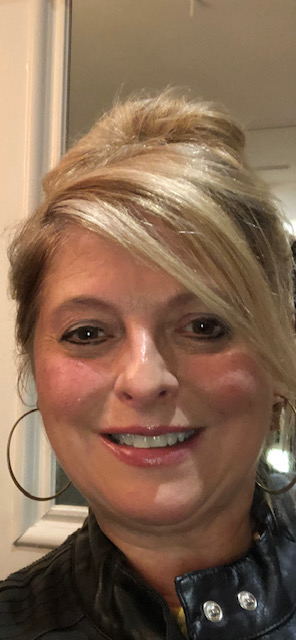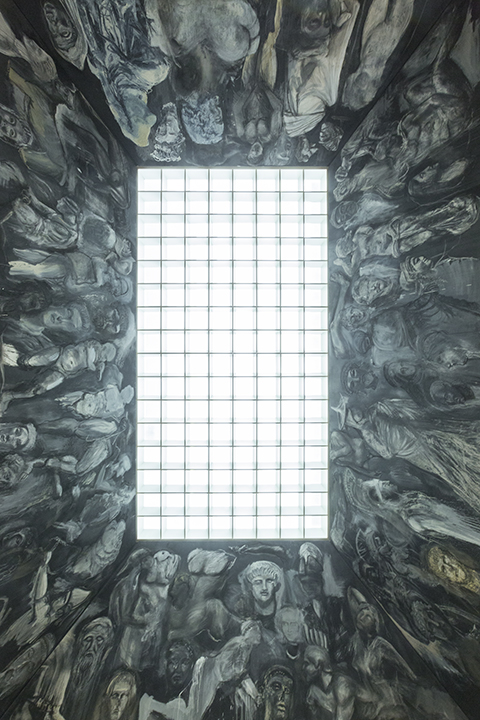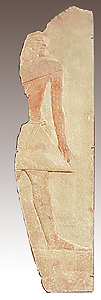 While the museum is closed, we’ve asked our docents to take us on “virtual tours,” showing us digitally some of their favorite works. Heidi Knapp was a nurse for 35 years, retiring in 2015. She’s spent quite a bit of time in museums in Europe and has been a docent since 2016. Here, she’ll explain why she often juxtaposes Jim Dine’s What was then, will never be again with a relief fragment from the tomb of Ptahhetep II at Saqqara.
While the museum is closed, we’ve asked our docents to take us on “virtual tours,” showing us digitally some of their favorite works. Heidi Knapp was a nurse for 35 years, retiring in 2015. She’s spent quite a bit of time in museums in Europe and has been a docent since 2016. Here, she’ll explain why she often juxtaposes Jim Dine’s What was then, will never be again with a relief fragment from the tomb of Ptahhetep II at Saqqara.
Why do you include these pieces in your tours?
I love to show the juxtaposition of the two pieces—our very oldest piece with one of our newest acquired works of art. I want them to think about how these two pieces ended up in the ancient gallery together.
Unknown, (Egyptian), Relief Fragment from Tomb of Ptahhetep II at Saqqara, 6th Dynasty (ca. 2460 – 2200 B.C.), 6th Dynasty, Limestone, red-brown pigment, 24 1/2 x 6 3/8 x 1 in., Class of 1948 Gift Fund purchase, 1973.141
What do you usually tell guests about these pieces?
I find that building their excitement before we get to Gallery 1 works best. I love to start my tour in the Mead Witter Lobby and build their anticipation by talking about Jim Dine’s piece in Gallery 1, What was then, will never be again. Without giving away too many details, we talk about Dine working for two years in his Paris studio.
 Jim Dine, (American, b. 1935), What was then, will never be again, 2015-2017, Acrylic paint, charcoal, pastel, crayon, oil stick, sepia ink, and India ink on polyester canvas glued to plywood boards, a: 85 7/8 x 312 3/8 in.; b: 85 7/8 x 96 1/2 in.; c: 85 7/8 x 312 3/8 in.; d: 85 7/8 x 96 1/2 in., Carolyn T. Anderson, Frank and Roa Birch, Eugenie Mayer Bolz, Chazen Museum of Art General, Class of 1929, Shirley G. Epstein, Walter A. and Dorothy Jones Frautschi, Alice Drews Gladfelter Memorial, Alexander and Henrietta W. Hollaender, Walter J. and Cecille Hunt, Stanley J. Lenerz, William R. Mitchell, Bertha Ardt Plaenert, Richard E. Stockwell, and Earl O. Vits Endowment Funds and Juli Plant Grainger Fund purchase, 2017.15a-d
Jim Dine, (American, b. 1935), What was then, will never be again, 2015-2017, Acrylic paint, charcoal, pastel, crayon, oil stick, sepia ink, and India ink on polyester canvas glued to plywood boards, a: 85 7/8 x 312 3/8 in.; b: 85 7/8 x 96 1/2 in.; c: 85 7/8 x 312 3/8 in.; d: 85 7/8 x 96 1/2 in., Carolyn T. Anderson, Frank and Roa Birch, Eugenie Mayer Bolz, Chazen Museum of Art General, Class of 1929, Shirley G. Epstein, Walter A. and Dorothy Jones Frautschi, Alice Drews Gladfelter Memorial, Alexander and Henrietta W. Hollaender, Walter J. and Cecille Hunt, Stanley J. Lenerz, William R. Mitchell, Bertha Ardt Plaenert, Richard E. Stockwell, and Earl O. Vits Endowment Funds and Juli Plant Grainger Fund purchase, 2017.15a-d
Once finished, he shipped his work to the Chazen by boat, train and finally truck. The Chazen had to close in order to allow for people’s safety, movement and installation of the piece. Before we climb the stairs, I love to tell them that in order to get the large piece into its permanent place, installers had to remove part of the railing and the bridge we will walk across. Once up the stairs to the yellow bridge, I have them cross it and imagine how large the piece of art must be in order for us to have removed the parts around them. Some younger visitors are afraid to cross our yellow bridge, and they sometimes grab a reassuring hand of a classmate. The suspense is building.
Once we arrive in Gallery 1, I explain that this ancient gallery holds our oldest items. I show them one of our oldest museum pieces, the relief fragment from the tomb of Ptahhetep II at Saqqara. I give them time to look at the relief and the surrounding pieces.
How do guests usually react to your must-sees?
After reading the label on the relief piece, younger tour groups love to guess who it may be on the relief. They also wonder why the edges are broken. Students love the ancient gallery with talks of tombs, the sarcophagus and funerary pieces. Their eyes light up with wonder and many times I am asked if the pieces are real. I then ask them to turn around in the gallery and remind them of the large piece that came from Paris. I allow them time to look and then guess which piece it is, eventually finding it on the ceiling.
Artist Jim Dine created the Glyptotek Drawings after visiting the Glyptothek Munich museum in 1984. His book of prints includes 40 drawings based on Roman and Greek antiquities. After my guests share who they may see in the drawings, I ask them if they think this new piece belongs here with the ancient art. They usually all agree that the ancient gallery is the perfect place for Dine’s work. I love looking at their expressions as they look up at the piece, many in awe and wonder. This is what makes being a docent rewarding and exciting to me.
Is there anything you would like to say to readers in this difficult time about art and the solace it can provide, or about the Chazen in general?
I want to encourage those seeking solace at this time to turn to art. Many museums, such as the Chazen, are making their collections more accessible with online tours. Spend time with your family touring online collections that you never dreamed of seeing. Share what art you find interesting and allow children to look at a piece of art, sharing their thoughts with you. You’ll be surprised what they see and know.
